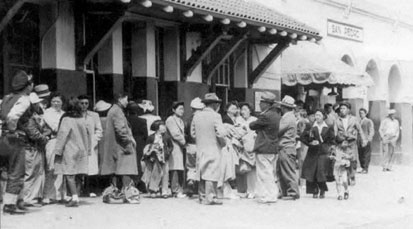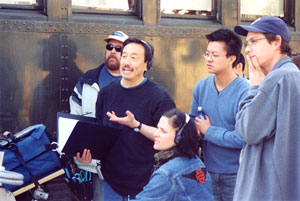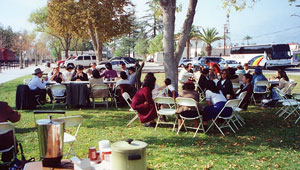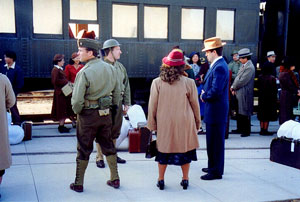 Stand Up for Justice, a docudrama about a young Latino who goes to Manzanar concentration camp with his Nisei friends, completed filming on December 12, 2002. The film was directed by John Esaki and produced by Amy Kato. Principal cast members included Alexis Cruz as Ralph Lazo and Chad Sakamoto, Brittany Ishibashi, and Marcus Toji as Ralph’s teenage friends. Actors Emily Kuroda, Tim Toyama, Ciro Suarez, Ron Martinez, Hiro Ueno and Takayo Fischer were also featured in the production. Key scenes were shot at the train museum in Fillmore, California and at the Manzanar National Historic site.
Stand Up for Justice, a docudrama about a young Latino who goes to Manzanar concentration camp with his Nisei friends, completed filming on December 12, 2002. The film was directed by John Esaki and produced by Amy Kato. Principal cast members included Alexis Cruz as Ralph Lazo and Chad Sakamoto, Brittany Ishibashi, and Marcus Toji as Ralph’s teenage friends. Actors Emily Kuroda, Tim Toyama, Ciro Suarez, Ron Martinez, Hiro Ueno and Takayo Fischer were also featured in the production. Key scenes were shot at the train museum in Fillmore, California and at the Manzanar National Historic site.
The 30-minute film explores the endearing values of friendship and loyalty between teenagers from different cultural and ethnic backgrounds and educates viewers about the hardships and deprivation of civil liberties that Japanese Americans faced during World War II.
Ralph Lazo was a Mexican-Irish American who spent just over two years at Manzanar as a voluntary internee. His closest friends were fellow high school students of Japanese descent who were abruptly and involuntarily removed from their homes and communities by the U.S. government in 1942. Ralph decided, much to the surprise of his Nisei friends, to join them on the train taking Japanese American internees to Manzanar. At Manzanar he stayed in camp barracks, was befriended by Issei internees, and graduated from Manzanar High School in 1944. He maintained life-long friendships with his Japanese American friends, and more than forty years later became active in the redress movement.
NCRR has long-wanted to capture Ralph Lazo’s story on film. Honored posthumously by NCRR at the 1992 “Day of Remembrance” in Los Angeles, Ralph never sought recognition for himself. During the years he lobbied for redress for Japanese Americans, Lazo insisted that the spotlight focus on his friends’ unjust incarceration during World War II. Stand Up for Justice is Ralph’s story recreated through interviews with his Nisei friends. It is NCRR’s and Visual Communications’ tribute to Ralph Lazo, a true friend of the Japanese American community.
 |
|
The director - John Esaki
|
COMMUNITY INVOLVEMENT
Ralph Lazo’s life has generated much interest among members of the Japanese American community and others interested in history, civil rights and community relations. Over 100 persons volunteered to be “extras” in the film, friends and businesses generously donated meals for the cast and crew, and the production members worked at reduced rates or volunteered their services to assure that the filming phase of the story was completed. Individuals belonging to groups such as the Manzanar Reunion Committee, the Manzanar Pilgrimage, East West Players and Cedar Grove Productions served as consultants to the project.
The morning film “shoot” at the Fillmore train museum was a true display of community involvement. With only five hours available for filming, the
Stand Up for Justice project initiated the day at 4:00 AM at Visual Communications for the costuming, hair styling and make-up of the more than 80 extras and actors. At the same time, the crew and supporting services assembled at the train station to prepare the site for filming. By 5:45 AM the first busload of extras had left for Fillmore. NCRR volunteers helped with set-up and brought and served food to project participants all morning long.
MARKETING AND PROMOTION
NCRR’s Education Committee members will promote Stand Up for Justice to teachers at workshops and at teacher conferences and will utilize their ties to secondary school materials distribution houses to market the film to schools. The video will impress upon viewers the significance of the United States government’s actions during World War II and the need to protect the civil rights of all of this country’s residents.
VISUAL COMMUNICATIONS will promote the film at its annual Los Angeles Asian Pacific Film and Video Festival and at other film festivals nationwide. After post-production, the film will also be viewed at community events such as the “Day of Remembrance” in Los Angeles and at remembrance programs in other cities.
THE ORGANIZATIONS
Nikkei for Civil Rights and Redress (NCRR) Education Committee is an advisory body to Stand Up for Justice, and one of its members, Janice Harumi Yen, is the Associate Producer. NCRR is dedicated to educating the public about the events of World War II, which led to the incarceration of 120,000 persons of Japanese ancestry in American concentration camps. Committee members have conducted numerous teacher-training workshops; have spoken at community programs and in college and high school classrooms about Japanese American history and the redress campaign which culminated in over 80,000 individuals receiving monetary compensation and a presidential apology. After September 11, 2001, NCRR members spoke out to advocate for the civil rights of Americans of Middle Eastern and South Asian descent, who, like the Japanese during World War II, have become the targets of racism. NCRR continues to develop positive ties to the Muslim American and Arab American communities.
 |
|
Extras relax between takes
|
Visual Communications, with a reputation as a premier media arts center devoted to honest and accurate portrayals of Asian Pacific Americans, is producing
Stand Up for Justice. John Esaki, Director, is on staff at the Japanese American National Museum (JANM) Media Services Department, and has produced and directed many films during his sixteen-year career at Visual Communications and JANM. His latest, Harsh Canvas: The Art and Life of Henry Sugimoto, was featured at the New York Asian Cinevision Film Festival. Producer Amy Kato has been a staff member at Visual Communications since 1981 and has produced many films including Yuki Shimoda: Asian American Actor and Maceo: Demon Drummer from East L.A. Michael Chin, Director of Photography, has served as cinematographer on numerous award-winning films including Chan in Missing, Dim Sum, Eyes on the Prize, I & II, and Nisei Soldier.
PRODUCTION TEAM
John Esaki and Amy Kato assembled a professional cast and crew that worked tirelessly during production. Because there was a time gap between the filming of the train scene at Fillmore and the remainder of the scenes, John and Amy had to assemble two separate production units. Among the crew, Janice Tanaka and Moises Velez, the Production Managers, admirably brought together the daily logistical elements. Michael Chin served as DP for the train scene and Dean Hayasaka was the DP for the other scenes including the difficult Manzanar outdoor scenes. Naomi Yoshida Rodriguez was the Costume Designer for the train scene and Steven Lee headed the Costume Design department for the second production unit. Kumiko Sato was chief of the Hair/Makeup department for the train scene while Cindy Nakadaira was the Head Hairstylist and Heema Arie the Head Make Up Artist for the rest of the film. Sound Mixer for the train scene was Jon Oh and Curtis Choy mixed the sound for the second production unit. Art Director for both units was Akeime Mitterlehner. The First Assistant Director, Ken Wada, who helped to produce a Day of Remembrance during the 1990’s, kept both crews on schedule.
 |
NCRR Education Committee members Patty Nagano and Kathy Nishimoto spent hours recruiting extras, assisted the costume designers fit the volunteers in period clothing, and worked with Director Esaki to choose background for the daily film shoot. Suzy Katsuda and Kay Ochi were in charge of Craft Services, which meant providing the cast and crew with three meals-a-day on a limited food budget. Suzy and Kay coordinated the many meal donations and won the acclaim of the production team for the quality and variety of meals they provided.
NCRR and Visual Communications have had a long history of work together. NCRR’s Education Committee collaborated with Visual Communications to preserve, summarize, and index the thirty-five-hour videotape of the 1981 Los Angeles Commission on Wartime Relocation and Internment of Civilians Hearings, and the relationship continued with the Lazo film.
POST-PRODUCTION
With the filming completed, post-production begins soon. Members of the post-production team will weave the raw footage into the 30-minute
Stand Up for Justice docu-drama. Music, historic film footage from World War II, and titles will be added to maximize the artistic impact of the film. Because the costs of filming a period piece exceed that of a more contemporary story, additional funds will need to be raised to cover the costs of post-production.
FUNDRAISING
Stand Up for Justice has received grants from the federally funded Civil Liberties Public Education Fund and the California State Civil Liberties Public Education Program. In addition, Eastman Kodak donated the super-16 mm film stock used in filming the docu-drama. Gratefully, donations have also been received from numerous individuals and organizations.
Because the two civil liberties grants and donations thus far received do not cover the total projected cost of producing
Stand Up for Justice, more funds need to be raised. Your help is needed to complete this important film. For more information, e-mail NCRR at
ncrrla@yahoo.com or the Lazo project at
ralphlazo@yahoo.com. Send tax-deductible donations to NCRR at 231 E. Third Street, Suite G-104,
Los Angeles, CA 90013 and indicate that the donation is for
Stand Up for Justice.

